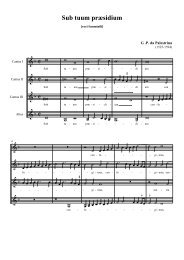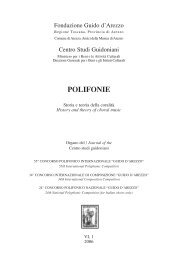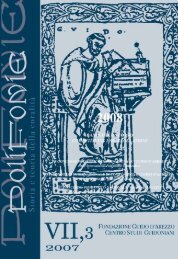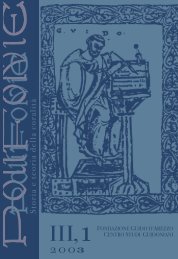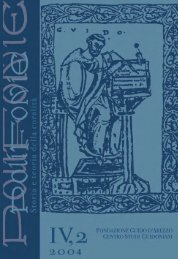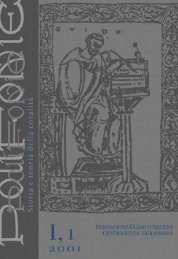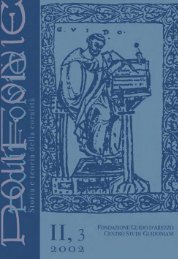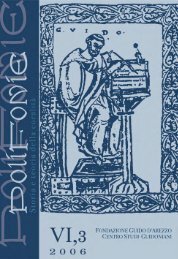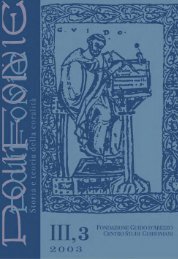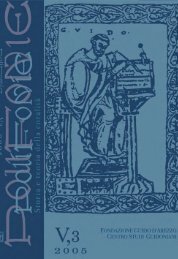Riviste Polifonie/119_2005 n 2.pdf - Fondazione Guido d'Arezzo
Riviste Polifonie/119_2005 n 2.pdf - Fondazione Guido d'Arezzo
Riviste Polifonie/119_2005 n 2.pdf - Fondazione Guido d'Arezzo
You also want an ePaper? Increase the reach of your titles
YUMPU automatically turns print PDFs into web optimized ePapers that Google loves.
MARCO GOZZI<br />
pating or postponing the melismas to the stressed syllables, a procedure that<br />
often broke up the original neumatic groups.<br />
The same sort of attitude guided the revisers of the 1591 Gradual. Certain<br />
interesting facts concerning its readings can be revealed by examining some<br />
sample passages.<br />
First of all let us look at the variants in the Kyrie fons bonitatis, the Kyrie<br />
which was used for the main feasts of the liturgical year and which normally<br />
opened the Kyriales placed at the end of the Graduals (now Vat. II, Graduale<br />
Triplex, 12 p. 715; Melnicki no. 48). 13 The rubric usually reads “In festivitatibus<br />
maioribus duplicibus” or, from c.1580, “In festivitatibus duplicibus primae<br />
classis”. FIGURE 8 gives a synoptic transcription of thirteen printed versions<br />
(from 1499 to 1653) of the central section of this Kyrie: the Christe eleison,<br />
which is repeated three times. While the Giunta and Liechtenstein Graduals<br />
from 1500 to 1580 are substantially the same from the melodic point of view<br />
(from 1525 onwards the initial note and certain melodic peaks are emphasized<br />
by an additional note of the same pitch, almost certainly to be performed<br />
without repetition), one can see that the Gardano Gradual of 1591 represents<br />
a genuine break with the manuscript and printed tradition. The melisma on the<br />
final syllable of Christe is reduced from 31 notes to 11. And while the threesyllable<br />
word e-lei-son in the 1580 edition had 6+4+1 syllables, in the Gardano<br />
Gradual the main melisma is shifted to the tonic syllable of the word (now<br />
given seven notes) while the outer syllables are left with just one. Also drastically<br />
eliminated are the characteristic descending scales of four or five notes<br />
(C B A G or C B A G F or A G F E D) that formed the musical substance of<br />
the invocation. This process of simplification, reduction of melismas and<br />
‘correction’ of syllable positions is carried out ‘at the drawing board’, so to<br />
speak, and heavy changes are made to the musical substance of the piece,<br />
effectively turning it into a different, new and totally recomposed work.<br />
It is also interesting to notice what happens after 1591 and observe how<br />
the subsequent book market behaves. The Spanish edition of 1597 gives a<br />
melodic version that is slightly different from the Venetian ones from 1525 to<br />
1580, by introducing a greater emphasis of the melodic peak on the note C<br />
through recourse to an upper auxiliary (C D C), yet it is substantially in line<br />
with the ancient tradition. Of great interest, on the other hand, is how the big<br />
Venetian publishers Giunta and Ciera behave in the 17th century, for both,<br />
between 1610 and 1618, adopt the archaic version of 1500 with very few<br />
12<br />
Graduale Triplex seu Graduale Pauli PP. VI cura recognitum..., Sablé sur Sarthe, Abbaye<br />
Saint-Pierre de Solesmes, 1979.<br />
13<br />
MARGARETA MELNICKI, Das einstimmige Kyrie des lateinischen Mittelalters, Diss., Universität<br />
Erlangen-Nürnberg, 1955.<br />
44



